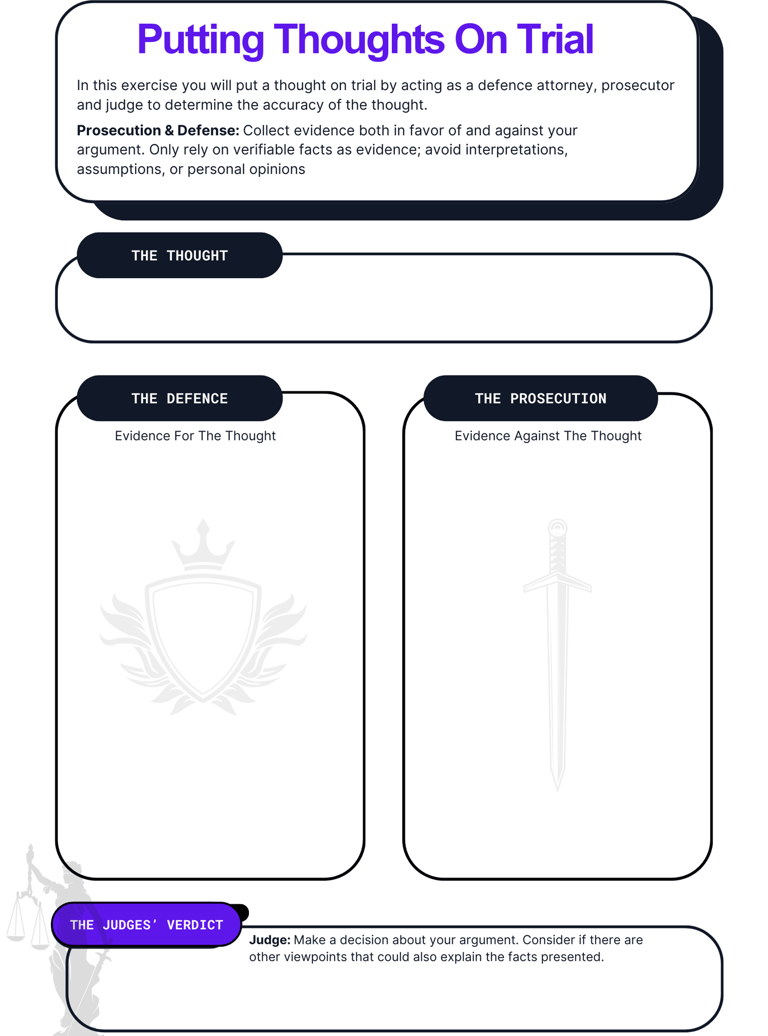Catching Your Thoughts and Challenging Negative Patterns
THINKING TRAPSANXIETYMENTAL HEALTH TOOLS


Introduction:
Our minds can sometimes get stuck in negative thought patterns that aren't always accurate. These are called cognitive distortions. They can make us feel bad about ourselves and the world around us. This worksheet will help you identify these distortions and challenge them with more balanced thinking.
Step 1: Notice Your Thoughts
Pay attention to your thoughts throughout the day. When you catch yourself feeling down or anxious, write down the thought that came to mind. Example: "I know my colleagues don't like me."
Step 2: Identify Your Feelings
List the emotions you experience alongside the thought. How do they feel in your body?
Example: "Anxious, like there is a weight on my chest. Lonely, and my body feels heavier and sinking. I am frustrated, and my face is flushing and my heart is pounding.


Step 3: Identify the Cognitive Distortion
Look for signs of cognitive distortions in your initial thought. Cognitive distortions are irrational or exaggerated thoughts that contribute to negative thinking patterns.
Identify which cognitive distortion(s) apply to your thought and write it down. Example: All-or-Nothing Thinking, Overgeneralization.
There are several common types of cognitive distortions, including:
1. All-or-Nothing Thinking: Seeing things in black and white, without considering any gray areas or middle ground. Example: "If my colleagues don't like me, then no one likes me."
2. Overgeneralization: Drawing broad conclusions based on a single event or piece of evidence. Example: "My colleagues didn't invite me to lunch today, so they must hate me."
3. Mental Filtering: Focusing only on the negative aspects of a situation and disregarding any positive aspects. Example: "My colleagues didn't compliment my presentation, so it must have been terrible."
4. Jumping to Conclusions: Making assumptions without any evidence or logical reasoning. Example: "My colleagues are whispering, they must be talking about me."
5. Catastrophizing: Exaggerating the importance or impact of a negative event or situation.
Example: "If my colleagues don't like me, I'll never succeed in this job."
Identify which cognitive distortion(s) apply to your thought and write it down. Example: All-or-Nothing Thinking, Overgeneralization.
Step 4: Evaluate the Evidence
Now that you've identified the cognitive distortions, it's time to look for evidence. Create two columns: one for evidence that supports your initial thought and another for evidence that contradicts it. Be honest and objective in your assessment.
Gather Evidence: Look for evidence that supports or contradicts your negative thought. Consider alternative explanations or perspectives. Example: "My colleagues may not have invited me to lunch because they had a meeting or had already made plans."
Evaluate the Evidence: Assess the credibility and validity of the evidence you've gathered. Is there more evidence to support your negative thought or to contradict it? Example: "There is no evidence to support the idea that my colleagues don't like me. In fact, there have been instances where they have been friendly and supportive."
Step 4: Challenge Your Thoughts / Find more balanced thoughts
Based on your evidence, formulate a more balanced and realistic thought.
3. Generate Alternative Thoughts: Come up with alternative, more balanced thoughts that challenge the negative thought. Example: "It's possible that my colleagues have other reasons for not inviting me to lunch. It doesn't mean they don't like me as a person."
4. Reevaluate Your Emotions: Consider how these alternative thoughts make you feel. Do they reduce the intensity of your negative emotions? Example: Feeling more open-minded, less anxious, and more willing to give my colleagues the benefit of the doubt.
TIP: Practice Self-Compassion
Remember to be kind to yourself throughout this process. Challenging negative thought patterns takes time and effort. Remind yourself that everyone has negative thoughts from time to time, and it doesn't define your worth or abilities.
Conclusion:
Catching and challenging negative thought patterns is an important step towards developing a more positive and balanced mindset. By recognizing cognitive distortions and replacing them with more realistic and balanced thoughts, you can improve your overall well-being and reduce unnecessary stress and anxiety. Practice these steps regularly to retrain your brain and cultivate a more positive outlook on life.


